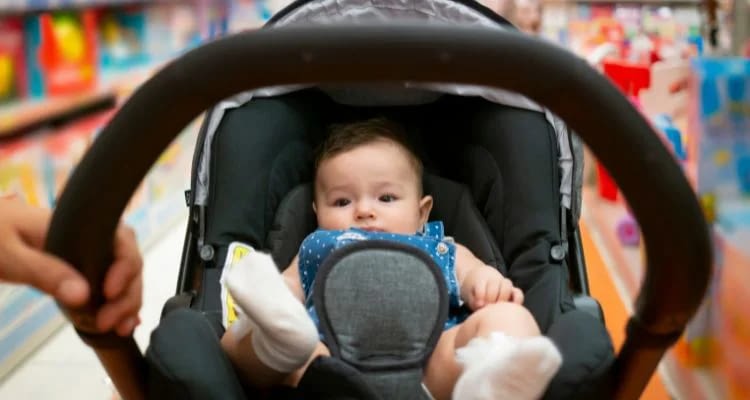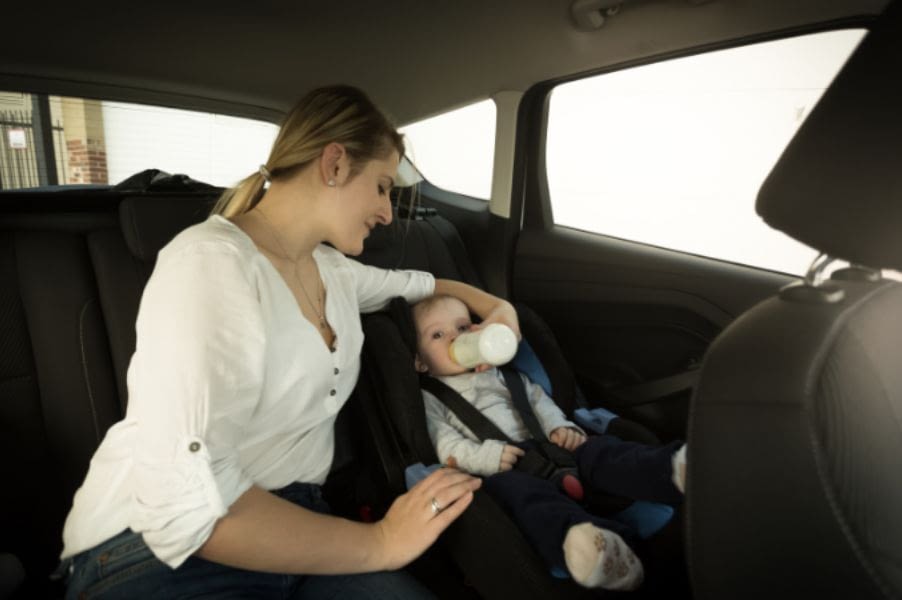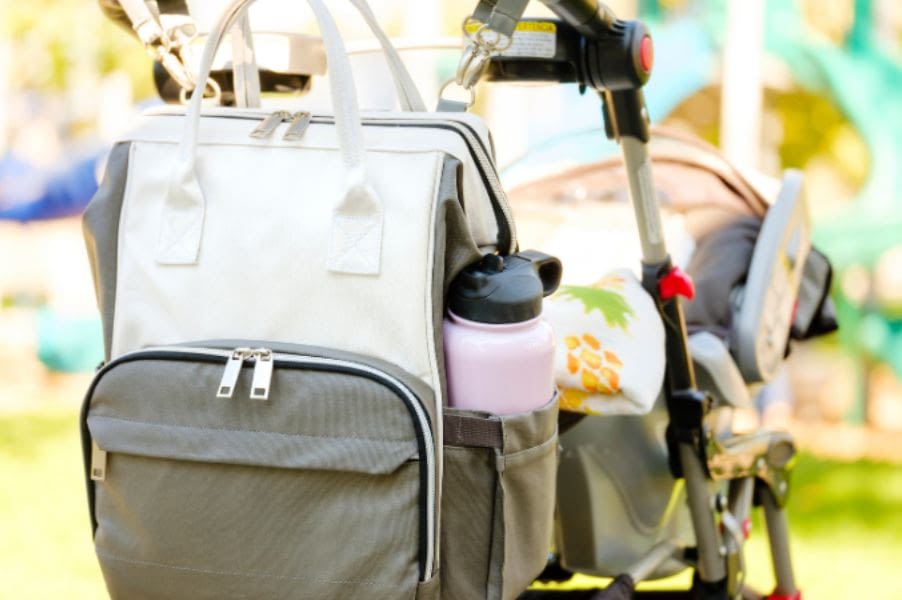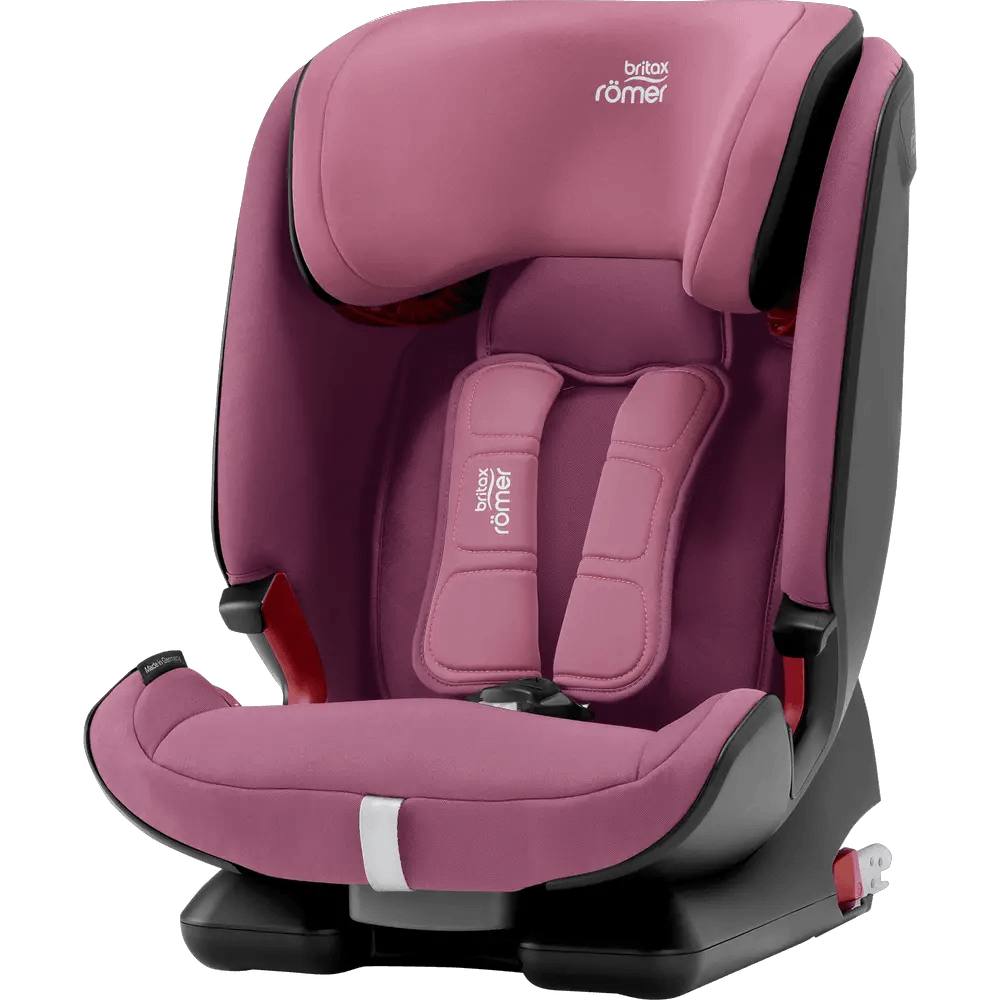Every parent awaits the day when their little one can comfortably sit in a stroller without a car seat. It signifies a new stage of development and mobility for the child. However, it’s crucial to ensure your baby’s safety and adhere to the appropriate guidelines before transitioning them from a car seat to a stroller.
This article will explore the factors determining when can baby sit in stroller without car seat, enabling you to make an informed decision while prioritizing your child’s well-being.
When it comes to using a stroller for a newborn, extra caution is necessary. Wait at least 2-3 months before putting your little one in the bassinet stroller. The car seat’s effectiveness depends on proper fitting and size, so follow instructions carefully.
Typically, around 5-6 months, when their bones are strong enough to support them. However, the time frame depends on your child’s development and when they can hold their head up.
Timing and carefully using a stroller are crucial for your baby’s safety and comfort. Be informed and make sure your child is ready before you take that first stroll.
Signs of readiness: When can baby sit in stroller without car seat?
When is it safe for your baby to sit in a stroller without a car seat? Knowing when to transition is essential to avoid any potential issues. Remember that every baby develops differently, so don’t compare your little one to others.
Newborns and Infants
Having your newborn in stroller without car seat insert is unsafe. Newborns and infants have little head and neck control, making them susceptible to head and neck injuries in case of sudden movements. Ensure the car seat insert is correctly installed and securely fastened to avoid mishaps. When can you take newborn outside in stroller? The AAP recommends rear-facing car seats for all infants until they’re at least two years old.
6-12 months old
At this age, babies can sit upright and hold their heads steady without support. You can remove the car seat insert and let your baby sit in the stroller. Ensure the stroller seat is well-padded to offer maximum comfort to your little one. You should also ensure the seat belt is buckled and properly adjusted to avoid falls.
1-year-old
Most babies can fully sit upright without any support by a year old. It’s safe to let your baby sit in the stroller seat without a car seat from this age. You can still opt to use a travel system stroller, where you can remove the car seat from the car and attach it to the stroller frame.
Toddler
Your child is around 2-3 years old and ready to graduate to a regular stroller without a car seat. Your toddler should be able to sit in the stroller seat without any support and strap themselves with the seat belt. Before switching to a regular stroller, test the harness and ensure your toddler sits safely on the stroller seat.
Read Also: Is it illegal to use an expired car seat?
When can baby sit in Graco stroller without car seat?
Most Graco strollers are designed for children six months and older or when they can sit up unassisted. However, since every child develops differently, checking with your pediatrician before allowing your baby to ride in the stroller without a car seat is essential.
Additionally, most Graco strollers come with an infant car seat adapter, so you can easily attach a compatible Graco infant car seat to the stroller and use it for your baby until they reach the minimum age requirement. It will help ensure your child is safe and secure while riding in the stroller.
When can baby sit in Chicco Bravo stroller?
Avoid placing your baby in a stroller before they can stand up independently. This usually happens between six to eight months of age.
However, Chicco does offer an infant insert for its Bravo stroller specifically designed for infants as young as three months old. This insert gives extra cushioning and support for younger babies, allowing them to sit safely and comfortably in the stroller.
The infant insert should not be used with children older than six months, which can cause a safety hazard.
When can baby sit in front facing stroller?
The baby should only sit in a front-facing stroller when 12 months old. Before that, babies should be securely placed in a rear-facing seat to ensure their safety and comfort.
If your stroller has both a rear-facing and front-facing option, you may switch it to the forward position when your baby reaches the appropriate age and weight limits specified by the manufacturer.
Always ensure your baby is properly secured with straps or harnesses, and check all safety features before using the stroller. Moreover, check your local laws and ordinances for additional safety requirements, such as when babies can sit facing forward in a stroller.

Factors to Consider: When to put baby in stroller without car seat chicco?
Welcoming a new addition to the family brings joy, excitement, and new responsibilities. One essential item on every parent’s checklist is a stroller. While car seats are mandatory for safe vehicle travel, many parents wonder when can baby sit in stroller seat uppababy.
Let’s explore the guidelines, recommendations, and factors to consider before transitioning your little one from a car seat to a stroller.
Understanding the Importance of Car Seats:
Car seats are specifically created to safeguard infants and young children while traveling in vehicles. They provide crucial support, restraint, and protection during sudden stops, turns, or accidents. Car seats significantly reduce the risk of injuries, making them essential to child safety.
The Age Milestones and their Development:
When can babies sit in stroller without car seat? It is determined by the baby’s developmental milestones, particularly their ability to stand independently. This milestone is usually reached between 6 and 8 months, but some babies may achieve it sooner or later. Remember that each child is different and may be ready to ride in a stroller with no car seat.
Motor Skills and Stability:
Before transitioning to a stroller, assessing your baby’s motor skills and stability is crucial. They should be able to hold their head up steadily without support, sit up unassisted, and have good neck and core strength. These physical developments indicate that your baby has the necessary stability and control to sit in an infant stroller without car seat.
Stroller Safety Features:
When selecting a stroller, prioritize safety features that provide adequate support and protection for your baby. Look for strollers with a sturdy frame, secure harness or seat belt, and adjustable recline options. These features help ensure your baby’s safety and comfort during stroller rides.
Smooth Terrain and Stroller Type:
When can baby ride in stroller? Consider the terrain you’ll be traversing with your baby in the stroller. Rough or uneven surfaces may require additional support, such as a car seat or an all-terrain stroller. Sturdy strollers with shock-absorbing features can provide a smoother ride for your little one, minimizing the risk of jostling or discomfort.
Weather Conditions:
Extreme weather conditions can affect your baby’s comfort and safety in a stroller. For example, ensure the stroller provides adequate ventilation and sun protection during hot weather. In colder climates, dress your baby in warm layers and use blankets to keep them cozy.
Start with Short Trips:
When transitioning your baby from a car seat to a stroller, begin with short trips to allow them to adjust to the new experience. Gradually increase the duration and distance of the stroller rides as your baby grows more comfortable and accustomed to sitting without a car seat.
Supervision and Vigilance:
Maintaining constant vigilance and supervision is crucial when your baby reaches an age where they can sit in a stroller without a car seat. Accidents can happen unexpectedly, and being alert and attentive ensures your baby’s safety.
Enjoying the Stroller Experience:
Take advantage of this freedom once your child is comfortable in the stroller and no longer needs a car seat. This can allow your child to interact and explore their surroundings while also interacting with you.
Which way should baby face in stroller?
Babies should not be exposed to direct sunlight for long periods in a stroller. When facing away from the sun, your baby can still see the world around them while being protected from heat and UV rays.
Additionally, consider covering your baby’s stroller with a blanket to provide shade and further protection from the sun. It is essential to ensure your baby’s head is not covered, as it can cause overheating and an increased risk of SIDS.
Instead, you can use built-in canopies. Finally, you should also check that the straps on the stroller are secure so your baby is always safe and comfortable. In addition to the sun, you should be aware of any hazards, such as busy streets, animals, or other external elements that could be potentially dangerous for your baby.
Constantly monitor where your stroller is going and avoid areas that might pose a risk. Moreover, you should also practice good stroller etiquette by ensuring your baby is covered when passing through crowded places such as supermarkets or shopping malls.
Considerations When Buying an Infant Stroller
When buying a newborn stroller without car seat, there are several important factors to consider. A stroller is essential for parents, providing a safe and convenient way to transport their little ones.
Choosing the right stroller can be overwhelming, with many available options. Let’s explore the key considerations when purchasing an infant stroller, ensuring you make an informed decision that meets your needs.
- Safety Features: Your child’s safety should be your top priority when selecting a stroller. Look for strollers that have a durable frame and are capable of withstanding everyday use. The harness system should have multiple points of attachment, ensuring your baby is secure and unable to climb out. Additionally, the stroller should have reliable brakes that can be easily engaged to prevent it from rolling away.
- Age and Weight Limitations: Consider the age and weight limitations of the stroller you are interested in. Some strollers are designed for newborns, while others are suitable for toddlers or older children. Ensure the stroller you choose accommodates your child’s weight and age, ensuring they will be comfortable and safe. It is also worth considering a stroller with adjustable features, allowing it to grow with your child.
- Maneuverability: Maneuverability is a crucial aspect to consider, affecting how easily you can navigate the stroller through various terrains. Look for strollers with swivel wheels, preferably with the option to lock them for stability on uneven surfaces. The stroller should have good suspension, enabling a smoother ride for your baby. Test the stroller’s maneuverability in the store before purchasing to ensure it meets your expectations.
- Folding and Storage: An important practical consideration is how easily the stroller can be folded and stored. Look for strollers that offer a compact fold and can fit into your vehicle’s trunk without taking up too much space. Some strollers come with one-hand folding mechanisms, which can be incredibly convenient when juggling a baby and other items. Consider the available storage space on the stroller, as it should have enough room for your essentials, such as a diaper bag and personal belongings.
- Comfort and Support: Your baby’s comfort and support should not be overlooked when choosing a stroller. Look for strollers with padded seats and adjustable recline positions, allowing your baby to sit or lie down comfortably. The seat should be well-padded and have a breathable fabric to prevent sweating. Additionally, check for adjustable footrests and a canopy that provides adequate shade and protection from the elements.
- Durability and Quality: Investing in a durable and high-quality stroller will ensure it withstands the test of time. Look for strollers made from sturdy materials that can handle regular use and occasional bumps. Review reviews and seek other parents’ recommendations to gauge the stroller’s durability. It is worth spending a little extra on a reliable and long-lasting stroller rather than constantly replacing a cheaper, lower-quality one.
- Storage and Accessories: Consider the storage options and accessories with the stroller. Some strollers have spacious storage baskets underneath, providing ample room for your baby’s essentials or your shopping bags. Look for strollers with additional accessories like a cup holder, snack tray, or rain cover. These accessories can significantly enhance your convenience and make outings with your baby more enjoyable.
- Easy Maintenance: Opt for a stroller that is easy to clean and maintain. Babies can be messy, and accidents happen, so choosing a stroller with removable and machine-washable fabric is important. Check if the stroller has easily accessible parts that can be wiped down or cleaned with minimal effort. Strollers with detachable and washable seat covers are highly recommended for easier maintenance.
- Customer Reviews and Recommendations: Before making a final decision, take the time to read customer reviews and seek recommendations from other parents based on their personal experiences.
- Budget Considerations: While it’s crucial to prioritize safety and quality, it’s also essential to consider your budget. Determine your budget range and look for strollers within that price range. Remember that a higher price doesn’t always guarantee the best quality, so carefully assess the stroller’s features, safety, and durability to ensure you get the best value.
When Can You Transition The Baby To A Regular Stroller Seat?
Most parents can transition their infant from a car seat to a regular stroller seat when they reach the age of 6 months. Children have developed strong head and neck control at this age and can sit upright without support for extended periods.
However, if your baby is not ready for the transition at six months, you should wait until your baby is comfortable and has developed the necessary muscle strength to sit up on their own. Furthermore, some strollers offer infant insert cushions or reclining seats that can be used for younger babies until they are ready for a regular seat. It’s essential to consider your baby’s development when transitioning from an infant car seat to a standard stroller seat.
You should also ensure your stroller’s harness system is secure and properly adjusted for your baby. It will ensure your baby is safe and comfortable while riding in the stroller. The American Academy of Pediatrics also recommends consistently placing babies in a rear-facing position when using a stroller. It is important to keep your baby safe and secure during the ride.
By taking these steps, you can ensure your infant has a comfortable transition from car seat to stroller while maintaining safety and security. Once they reach 6 months, you can introduce them to the regular stroller seat and adjust the harness accordingly. With time and patience, you can ensure that your 6 month old in stroller is happy and safe during their ride.
Conclusion: when can a baby sit in a stroller?
Ensuring your baby’s safety is essential by following the recommended guidelines. Always refer to the manufacturer’s guidelines and safety instructions before using your baby’s stroller. Remember, each baby is different and reaches their developmental milestones at their own pace. Don’t push your baby to reach milestones faster. Take it easy and celebrate each step together as a family.
Parents Also Ask
Do newborns need a special stroller?
Newborns typically require a car seat designed to fit into the stroller frame. It helps keep the infant secure and comfortable while the parent pushes them around. Some strollers even come with an infant insert cushion that can be used for younger babies.
Is stroller safe for overnight sleep?
Strollers are not designed to provide the same level of comfort and support that a crib or bassinet can offer and are not approved for safe sleeping. Therefore, moving your baby from the stroller to a safe sleeping area when it is time for them to rest is safest.
At what age can babies use a regular stroller seat?
Most babies can transition from an infant car seat to a regular stroller seat when they reach the age of 6 months.
Do I need a five-point harness?
A five-point harness is necessary to keep children safe while riding in the stroller. The five points of the harness should be buckled up snugly to ensure your baby is properly secured.
1 Visit today





